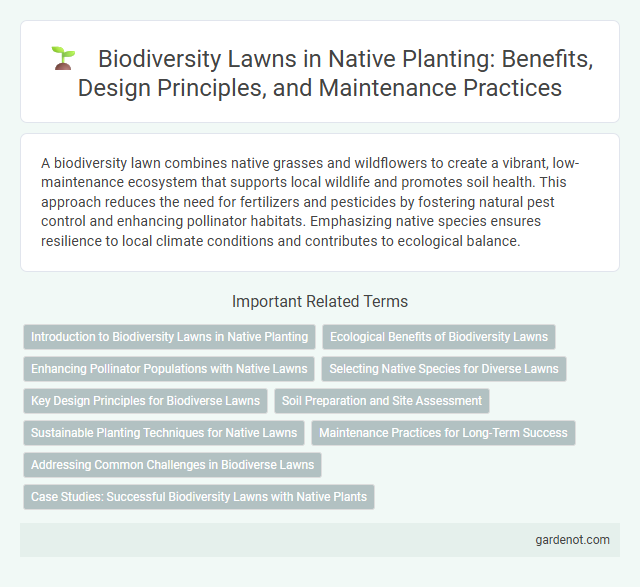A biodiversity lawn combines native grasses and wildflowers to create a vibrant, low-maintenance ecosystem that supports local wildlife and promotes soil health. This approach reduces the need for fertilizers and pesticides by fostering natural pest control and enhancing pollinator habitats. Emphasizing native species ensures resilience to local climate conditions and contributes to ecological balance.
Introduction to Biodiversity Lawns in Native Planting
Biodiversity lawns integrate native plant species to enhance ecosystem resilience and support local wildlife habitats. These lawns prioritize a variety of grasses, wildflowers, and groundcovers that require less water, fertilizer, and maintenance compared to traditional turfgrass. By promoting native biodiversity, biodiversity lawns contribute to improved soil health, pollinator populations, and overall environmental sustainability.
Ecological Benefits of Biodiversity Lawns
Biodiversity lawns enhance soil health by supporting diverse microbial populations and improving nutrient cycling. Native plants within these lawns create habitats for pollinators, birds, and beneficial insects, increasing local wildlife populations. These lawns reduce the need for chemical fertilizers and pesticides, promoting sustainable and eco-friendly landscaping practices.
Enhancing Pollinator Populations with Native Lawns
Native lawns significantly boost pollinator populations by providing diverse, nectar-rich plants that support bees, butterflies, and other beneficial insects throughout their life cycles. Incorporating species like wildflowers, clover, and native grasses creates a resilient habitat that maintains soil health and promotes ecosystem stability. These biodiversity-rich lawns reduce the need for chemical inputs, fostering sustainable environments that attract a wide range of pollinators essential for local flora and agriculture.
Selecting Native Species for Diverse Lawns
Selecting native species for a biodiversity lawn enhances local ecosystems by providing habitat and food sources for pollinators, birds, and other wildlife. Incorporating a mix of native grasses, wildflowers, and groundcovers ensures diverse root structures and flowering times, promoting soil health and continuous seasonal interest. Prioritizing region-specific plants reduces maintenance needs and water usage while supporting genetic diversity essential for long-term ecological resilience.
Key Design Principles for Biodiverse Lawns
Biodiversity lawns integrate native plants to enhance ecosystem health, prioritizing species diversity, structural variety, and seasonal bloom patterns. Incorporating deep-rooted grasses and flowering perennials improves soil quality and supports pollinators like bees and butterflies. Design principles emphasize layered vegetation, minimal turf monoculture, and habitat connectivity to foster resilient, sustainable green spaces.
Soil Preparation and Site Assessment
Soil preparation and site assessment are critical for establishing a biodiversity lawn with native plants. Assessing soil composition, pH levels, drainage patterns, and existing vegetation helps determine the optimal native species to support local ecosystems. Proper soil amendment with organic matter enhances nutrient availability and promotes healthy root development essential for diverse, resilient plant communities.
Sustainable Planting Techniques for Native Lawns
Sustainable planting techniques for native lawns emphasize biodiversity by incorporating a diverse mix of grasses, wildflowers, and groundcovers that are adapted to local ecosystems. These techniques promote soil health, reduce water usage, and provide habitat for pollinators and beneficial insects. Native species such as buffalo grass, blue grama, and little bluestem enhance lawn resilience while supporting regional wildlife and ecosystem balance.
Maintenance Practices for Long-Term Success
Biodiversity lawns require minimal mowing and selective watering to promote native plant resilience and ecosystem balance. Integrating periodic soil testing and adaptive mulching enhances nutrient cycling and supports beneficial microorganisms. These maintenance practices foster robust growth and sustained habitat for pollinators and wildlife over time.
Addressing Common Challenges in Biodiverse Lawns
Biodiversity lawns overcome common challenges such as soil erosion, pest control, and water conservation by incorporating native grasses and wildflowers that promote resilient ecosystems. These plants support diverse pollinators and beneficial insects, reducing the need for chemical treatments and enhancing soil health through natural nutrient cycling. Proper selection and maintenance of native species ensure a low-maintenance, drought-tolerant lawn that thrives in local conditions while fostering ecological balance.
Case Studies: Successful Biodiversity Lawns with Native Plants
Case studies of biodiversity lawns demonstrate how native plants significantly enhance local ecosystems by providing habitat and food sources for pollinators, birds, and beneficial insects. In regions like the Midwest US, native prairie grasses and wildflowers have replaced traditional turf, resulting in reduced maintenance, improved soil health, and increased species diversity. These successful biodiversity lawns highlight the importance of selecting regionally adapted natives such as Echinacea purpurea and Andropogon gerardii to create resilient, ecologically rich landscapes.
Biodiversity lawn Infographic

 gardenot.com
gardenot.com